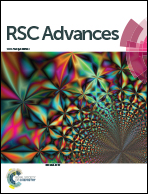Two-reactor, continuous culture fermentation for fuel ethanol production from lignocellulosic acid hydrolysate using Zymomonas mobilis and Scheffersomyces stipitis†
Abstract
Conversion of mixed sugars into bioethanol was investigated in a continuous, two-stage bioreactor setup connected in series. The first reactor was inoculated with Z. mobilis, a hexose-fermenting bacterium, and the second reactor was inoculated with S. stipitis, a well-known pentose-fermenting yeast. The reactors were switched on to the continuous mode after 24 h of initial batch run. Different flow rates were tested for complete utilization of hexose sugars and maximal xylose fermentation. Using this system at 100 ml h−1 flow rate, an overall 1.37 g l−1 h−1 ethanol productivity (rp) was obtained with un-detoxified acid hydrolysate as compared to 1.56 g l−1 h−1 with pure sugars. Using un-detoxified acid hydrolysate, the maximum ethanol yield Yp/s with Z. mobilis was found to be 0.47 g g−1 (92%); with S. stipitis, it was found to be 0.45 g g−1 (88%). Hexose sugars were completely utilized, with approximately 40% xylose utilization in the un-detoxified acid hydrolysate. On the other hand, during the fermentation of pure sugars, more than 60% xylose was utilized, with complete utilization of glucose.


 Please wait while we load your content...
Please wait while we load your content...